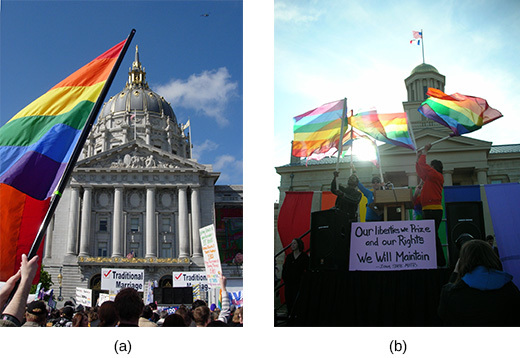| << Chapter < Page | Chapter >> Page > |

Watch this detailed documentary on the attitudes that prevailed in Colorado in 1992, when the voters of that state approved Amendment 2 to the state’s constitution and consequently denied gay and lesbian Coloradans the right to claim relief from local levels of discrimination in public accommodations, housing, or jobs.
While those in support of broadening civil rights to include same-sex marriage were optimistic, those opposed employed new tactics. In 2008, opponents of same-sex marriage in California tried a ballot initiative to define marriage strictly as a union between a man and a woman. Despite strong support for broadening marriage rights, the proposition was successful. This change was just one of dozens that states had been putting in place since the late 1990s to make same-sex marriage unconstitutional at the state level. Like the California proposition, however, many new state constitutional amendments have faced challenges in court ( [link] ). As of 2014, leaders in both political parties are more receptive than ever before to the idea of same-sex marriage.


Visit the Pew Research site to read more about the current status of same-sex marriage in the United States and the rest of the world.
Even as mainstream members of both political parties moved closer together on same-sex marriage, political divisions on scientific debates continued. One increasingly polarizing debate that baffles much of the rest of the world is about global climate change. Despite near unanimity in the scientific community that climate change is real and will have devastating consequences, large segments of the American population, predominantly on the right, continue to insist that it is little more than a complex hoax and a leftist conspiracy. Much of the Republican Party’s base denies that global warming is the result of human activity; some deny that the earth is getting hotter at all. This popular denial has had huge global consequences. In 1998, the United States, which produces roughly 36 percent of the greenhouse gases like carbon dioxide that prevent the earth’s heat from escaping into space, signed the Kyoto Protocol , an agreement among the world’s nations to reduce their emissions of these gases. President Bush objected to the requirement that major industrialized nations limit their emissions to a greater extent than other parts of the world and argued that doing so might hurt the American economy. He announced that the United States would not be bound by the agreement, and it was never ratified by Congress.
Instead, the Bush administration appeared to suppress scientific reporting on climate change. In 2006, the progressive-leaning Union of Concerned Scientists surveyed sixteen hundred climate scientists, asking them about the state of federal climate research. Of those who responded, nearly three-fourths believed that their research had been subjected to new administrative requirements, third-party editing to change their conclusions, or pressure not to use terms such as “global warming.” Republican politicians, citing the altered reports, argued that there was no unified opinion among members of the scientific community that humans were damaging the climate.
Countering this rejection of science were the activities of many environmentalists, including Al Gore, Clinton’s vice president and Bush’s opponent in the disputed 2000 election. As a new member of Congress in 1976, Gore had developed what proved a steady commitment to environmental issues. In 2004, he established Generation Investment Management, which sought to promote an environmentally responsible system of equity analysis and investment. In 2006, a documentary film, An Inconvenient Truth , represented his attempts to educate people about the realities and dangers of global warming, and won the 2007 Academy Award for Best Documentary. Though some of what Gore said was in error, the film’s main thrust is in keeping with the weight of scientific evidence. In 2007, as a result of these efforts to “disseminate greater knowledge about man-made climate change,” Gore shared the Nobel Peace Prize with the Intergovernmental Panel on Climate Change.
The nation’s increasing diversity—and with it, the fact that white Caucasians will soon be a demographic minority—prompted a conservative backlash that continues to manifest itself in debates about immigration. Questions of who is an American and what constitutes a marriage continue to be debated, although the answers are beginning to change. As some states broadened civil rights to include gays and lesbians, groups opposed to these developments sought to impose state constitutional restrictions. From this flurry of activity, however, a new political consensus for expanding marriage rights has begun to emerge. On the issue of climate change, however, polarization has increased. A strong distrust of science among Americans has divided the political parties and hampered scientific research.

Notification Switch
Would you like to follow the 'U.s. history' conversation and receive update notifications?